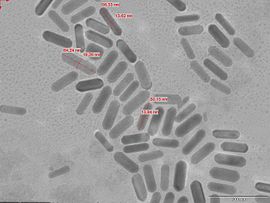
Back Nanorod Catalan Nanorod Spanish نانومیله Persian Nanotige French Nanobarra Italian Nanostaafjes Dutch Наностержень Russian Нанострижень Ukrainian

In nanotechnology, nanorods are one morphology of nanoscale objects. Each of their dimensions range from 1–100 nm. They may be synthesized from metals or semiconducting materials.[1] Standard aspect ratios (length divided by width) are 3-5. Nanorods are produced by direct chemical synthesis. A combination of ligands act as shape control agents and bond to different facets of the nanorod with different strengths. This allows different faces of the nanorod to grow at different rates, producing an elongated object.
One potential application of nanorods is in display technologies, because the reflectivity of the rods can be changed by changing their orientation with an applied electric field. Another application is for microelectromechanical systems (MEMS). Nanorods, along with other noble metal nanoparticles, also function as theragnostic agents. Nanorods absorb in the near IR, and generate heat when excited with IR light. This property has led to the use of nanorods as cancer therapeutics. Nanorods can be conjugated with tumor targeting motifs and ingested. When a patient is exposed to IR light (which passes through body tissue), nanorods selectively taken up by tumor cells are locally heated, destroying only the cancerous tissue while leaving healthy cells intact.
Nanorods based on semiconducting materials have also been investigated for application as energy harvesting and light emitting devices. In 2006, Ramanathan et al. demonstrated1 electric-field mediated tunable photoluminescence from ZnO nanorods, with potential for application as novel sources of near-ultraviolet radiation.
- ^ Sadri, Rad (15 January 2021). "Controlled physical properties and growth mechanism of manganese silicide nanorods". Journal of Alloys and Compounds. 851: 156693. doi:10.1016/j.jallcom.2020.156693. S2CID 224922987.
© MMXXIII Rich X Search. We shall prevail. All rights reserved. Rich X Search